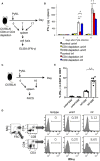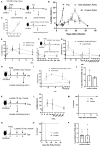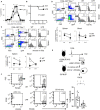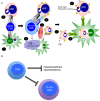Fluctuations of Spleen Cytokine and Blood Lactate, Importance of Cellular Immunity in Host Defense Against Blood Stage Malaria Plasmodium yoelii
- PMID: 31608052
- PMCID: PMC6773889
- DOI: 10.3389/fimmu.2019.02207
Fluctuations of Spleen Cytokine and Blood Lactate, Importance of Cellular Immunity in Host Defense Against Blood Stage Malaria Plasmodium yoelii
Abstract
Our previous studies of protective immunity and pathology against blood stage malaria parasites have shown that not only CD4+ T cells, but also CD8+ T cells and macrophages, are important for host defense against blood stage malaria infection. Furthermore, we found that Plasmodium yoelii 17XNL (PyNL) parasitizes erythroblasts, the red blood cell (RBC) precursor cells, which then express MHC class I molecules. In the present study, we analyzed spleen cytokine production. In CD8+ T cell-depleted mice, IL-10 production in early stage infection was increased over two-fold relative to infected control animals and IL-10+ CD3- cells were increased, whereas IFN-γ production in the late stage of infection was decreased. At day 16 after PyNL infection, CD8+ T cells produced more IFN-γ than CD4+ T cells. We evaluated the involvement of the immunoproteasome in induction of immune CD8+ T cells, and the role of Fas in protection against PyNL both of which are downstream of IFN-γ. In cell transfer experiments, at least the single molecules LMP7, LMP2, and PA28 are not essential for CD8+ T cell induction. The Fas mutant LPR mouse was weaker in resistance to PyNL infection than WT mice, and 20% of the animals died. LPR-derived parasitized erythroid cells exhibited less externalization of phosphatidylserine (PS), and phagocytosis by macrophages was impaired. Furthermore, we tried to identify the cause of death in malaria infection. Blood lactate concentration was increased in the CD8+ T cell-depleted PyNL-infected group at day 19 (around peak parasitemia) to similar levels as day 7 after infection with a lethal strain of Py. When we injected mice with lactate at day 4 and 6 of PyNL infection, all mice died at day 8 despite demonstrating low parasitemia, suggesting that hyperlactatemia is one of the causes of death in CD8+ T cell-depleted PyNL-infected mice. We conclude that CD8+ T cells might control cytokine production to some extent and regulate hyperparasitemia and hyperlactatemia in protection against blood stage malaria parasites.
Keywords: CD4 T cell; CD8 T cell; T cell; erythroblast; macrophage; malaria.
Copyright © 2019 Imai, Suzue, Ngo-Thanh, Ono, Orita, Suzuki, Shimokawa, Olia, Obi, Taniguchi, Ishida, Van Kaer, Murata, Tanaka and Hisaeda.
Figures









Similar articles
-
Involvement of CD8+ T cells in protective immunity against murine blood-stage infection with Plasmodium yoelii 17XL strain.Eur J Immunol. 2010 Apr;40(4):1053-61. doi: 10.1002/eji.200939525. Eur J Immunol. 2010. PMID: 20101613
-
Listeria monocytogenes inoculation protects mice against blood-stage Plasmodium yoelii infection.Tohoku J Exp Med. 2013 Feb;229(2):87-96. doi: 10.1620/tjem.229.87. Tohoku J Exp Med. 2013. PMID: 23303295
-
Cytotoxic activities of CD8⁺ T cells collaborate with macrophages to protect against blood-stage murine malaria.Elife. 2015 Mar 11;4:e04232. doi: 10.7554/eLife.04232. Elife. 2015. PMID: 25760084 Free PMC article.
-
Cellular mechanisms in immunity to blood stage infection.Immunol Lett. 1990 Aug;25(1-3):109-14. doi: 10.1016/0165-2478(90)90100-5. Immunol Lett. 1990. PMID: 1980907 Review.
-
[Immunology of human Plasmodium falciparum malaria].Ann Soc Belg Med Trop. 1995 Sep;75(3):159-78. Ann Soc Belg Med Trop. 1995. PMID: 8849294 Review. French.
Cited by
-
Elicitation of T-cell-derived IFN-γ-dependent immunity by highly conserved Plasmodium ovale curtisi Duffy binding protein domain region II (PocDBP-RII).Parasit Vectors. 2023 Aug 8;16(1):269. doi: 10.1186/s13071-023-05897-9. Parasit Vectors. 2023. PMID: 37553591 Free PMC article.
-
Severe malaria enforces short-lived effector cell differentiation but does not prevent effective secondary responses by memory CD8 T cells.PLoS Pathog. 2025 Mar 31;21(3):e1012993. doi: 10.1371/journal.ppat.1012993. eCollection 2025 Mar. PLoS Pathog. 2025. PMID: 40163479 Free PMC article.
-
B cell intrinsic expression of IFNλ receptor suppresses the acute humoral immune response to experimental blood-stage malaria.Virulence. 2020 Dec;11(1):594-606. doi: 10.1080/21505594.2020.1768329. Virulence. 2020. PMID: 32407154 Free PMC article.
-
Live Vaccination with Blood-Stage Plasmodium yoelii 17XNL Prevents the Development of Experimental Cerebral Malaria.Vaccines (Basel). 2022 May 11;10(5):762. doi: 10.3390/vaccines10050762. Vaccines (Basel). 2022. PMID: 35632518 Free PMC article.
-
Potential and Limitations of Cross-Protective Vaccine against Malaria by Blood-Stage Naturally Attenuated Parasite.Vaccines (Basel). 2020 Jul 11;8(3):375. doi: 10.3390/vaccines8030375. Vaccines (Basel). 2020. PMID: 32664476 Free PMC article.
References
-
- Wizel B, Houghten RA, Parker KC, Coligan JE, Church P, Gordon DM, et al. . Irradiated sporozoite vaccine induces HLA-B8-restricted cytotoxic T lymphocyte responses against two overlapping epitopes of the Plasmodium falciparum sporozoite surface protein 2. J Exp Med. (1995) 182:1435–45. 10.1084/jem.182.5.1435 - DOI - PMC - PubMed
Publication types
MeSH terms
Substances
LinkOut - more resources
Full Text Sources
Medical
Molecular Biology Databases
Research Materials
Miscellaneous

